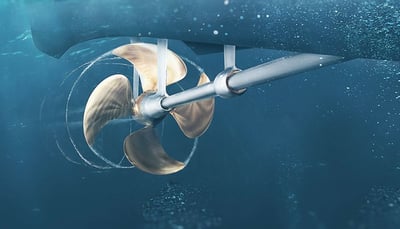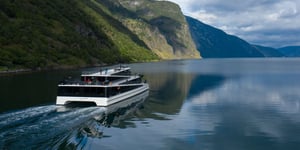Consider this; if you can reduce energy consumption by 30% due to the propulsion system, there is a 30% reduction in energy cost, and a 30% reduction in pollution.
Today, there is a collective strive towards zero emissions, causing the price of releasing CO2 and NOX emissions to increase every year. Furthermore, stricter regulations are being introduced and it is crucial to ensure that you do not put a vessel into operation, without it meeting the current environmental requirements and having the ability to meet more strict regulations in the future.
Whether you think green or economics, what’s important when choosing a propulsion system, is that you must have as efficient a system as possible, because it will affect both aspects.
In this blog article, we will briefly look at energy sources used, before we discuss what elements make a propulsion system efficient both in terms of environment and cost, and what type of system is considered to be the most environmentally friendly.
Energy sources
The standard method of propulsion today are diesel engines that unfortunately contribute to greenhouse gas emissions. Very often these engines tend to run outside its most optimum operation area, leading to an efficiency below 50%, causing unnecessary use of fossil fuels.
However, the configuration with a diesel engine connected to a propeller via a gearbox has the lowest energy losses of all different propulsion configurations in the market today.
Propulsion systems driven by fossil fuels can vary from a simple diesel engine connected to a propeller shaft, to more complex systems combining diesel engines with electrical generators.
However, with the current focus on sustainability, the marine propulsion energy market is driven by the strive towards zero emissions. Not only due to the environmental benefits, but also because of the cost benefits associated with electric or hybrid solutions. Another important factor is the recently increased price on fossil fuels.
Hybrid battery installations allow diesel engines to operate up to 20% more efficiently by using the batteries in a way that allows the engine to run at its optimum speed and power.
What makes a propulsion system efficient?
When designing and building a propulsion system, it is crucial that you focus on having fine hull lines and reduced resistance in the sea. It’s easy to make the mistake of making a standard simple hull without considering all the equipment and weight that goes into it. Make sure that all appendixes (brackets, rudders etc.) is as optimal as possible, reducing the resistance in the water as much as possible.
The propeller diameter should be as large as possible thus needing lower speed on the propeller. For a high-speed vessel, it is imperative to focus on the weight of the installed equipment as well as the hull and superstructure itself. Any excessive weight will increase the draught of the vessel, hence increasing the resistance in the water which leads to a higher energy consumption.
Choosing electrical power over a diesel engine is by far the most environmentally friendly option.
However, vessels using electrical power will have big batteries and therefor be very heavy, and the vessel will lay deeper in the water. Consequently, the vessel’s resistance will increase, and you need more energy to move the vessel.
Read more: What is Important When Selecting Propulsion Technology
The most environmentally friendly system
A controllable pitch propeller has more potential to be effective over the entire speed range from maneuvering to top speed than many other systems that has one optimum design point hence loosing efficiency on other operating profiles.
The Controllable Pitch Propeller (CPP) and its corresponding tunnel might be the most expensive propulsion system to buy and install, but it is much more efficient. You can reduce the cost by buying a smaller battery pack, and the total cost may even out. If you install a smaller battery pack, you get a lighter vessel that will use less energy.
Due to its versatility, the vessel is thus able to obtain a good energy efficiency (OPEX). The reduced energy consumption enables Zero Emission energy sources to be utilized more efficient. When considering a propulsion system, it is highly necessary to think both CAPEX and OPEX. The CPP working in a well-designed tunnel, and with appendixes with as low resistance as possible, is the obvious winner in this assessment.
 The CPP is also the most adaptable propulsion system – it’s much more efficient to adapt the CPP to batteries, hydrogen or new fuels with lower energy density than diesel, compared to the water jet and FPP.
The CPP is also the most adaptable propulsion system – it’s much more efficient to adapt the CPP to batteries, hydrogen or new fuels with lower energy density than diesel, compared to the water jet and FPP.
Of course, the operating profile of the vessel is important to keep in mind. If the area of operation is in shallow waters, a propeller might not be possible, and you’ll need a different propulsion solution.
An important factor that needs to be addressed is the infrastructure for power requirement and charging systems onshore that needs to be in place. Unless the electric power used to charge the batteries are produced from a green power source, the impact from the emissions will still have a negative effect on the environment, even if the local benefit may be increased. (Zero emission in harbor).
Read more: Potential Fuel Saving in Converting From Water Jet to CPP
Conclusion
When choosing a propulsion system for your vessel, economics and environment go hand in hand. A propulsion system that is environmentally friendly will also be expensive due to the heavy battery, thus needing more power to run the vessel.
Looking at the total economic and environmental picture, the CPP is the best option with its variable pitch propeller – not considering the operation profile where this type might be unsuitable due to e.g., draught restrictions.
A propulsion system that is environmentally friendly is more expensive than a standard system. To meet the strive towards zero emissions, the incentives must be in place. It must be cheaper for the shipowner to operate a zero-emission vessel. If not, it will be difficult to speed up the developments of this type of system.



